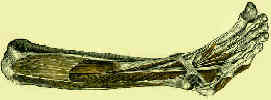- See: Anterior Compartment:
- Anatomy:
- origin: lateral condyle of tibia, proximal 2/3 of lateral surface of tibia, interosseous membrane, deep fascia and
lateral intermuscular septum;
- insertion: plantar surface on base of first metatarsal and medial plantar surface of 1st cuneiform;
- action: dorsiflexes and inverts foot at the ankle;
- reversed origin insertion action:
- when standing, the foot is fixed & becomes origin;
- action causes forward body lean antagonistic to plantar flexion of soleus and gastrocnemius;
- active in balance mechanism of anterior and posterior sway;
- nerve supply: peroneal, L4 > L5, S1; (see Innervation)
- synergists: extensor hallucis longus, externsor digitorum longus;
- Discussion: Paralysis:
- may occur from polio;
- paralysis results in loss of dorsiflexor & invertor power & results in development of equinovalgus deformity;
- this is seen initially during swing phase of gait as moderate equinovalgus with forefoot eversion;
- later w/ more severe disease this will be seen in both phases of gait;
- to compensate, long toe extensors, function as dorsiflexors & become overactive during swing phase;
- hyperextension of the proximal phalanges and depression of the metatarsal heads results;
- contracture of ankle gradually develops as functioning triceps contracts;
- occassionally, the unopposed activity of the peroneus longus, which depresses the first metatarsal, combines with an
active tibialis posterior to cause formation of a cavovarus deformity;
- treatment:
- transferthe EHL tendon to bases of the first metatarsal;
- when peroneus tertius is functioning, it may be transferred along w/ EHL to the base of the first metatarsal;
- plantar fasciotomy may be needed
- when foot is severly relaxed or when the valgus deformity is fixed, tendon transfer is combined w/ triple arthrodesis ;
- Ruptured Tibial Anterior:
- symptoms of a ruptured tibialis anterior tendon are a sudden sharp pain and swelling over the first cuniform, accompanied by an
inability to coordinate normal foot motion;
- Role of Tibialis Anterior in Club Foot:
- anterior tibial muscle has a strong supinatory action when abnormal relationship between the talus & calcaneus is not been
corrected
The results of transfer of the tibialis anterior to the heel in patients who have a myelomeningocele.
Posterior transfer of the anterior tibial tendon in children who have a myelomeningocele.
Pathophysiology of Charcot-Marie-Tooth disease.
Transfer of the tibialis anterior for calcaneus deformity in myelodysplasia.


